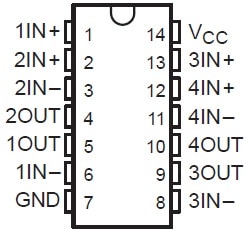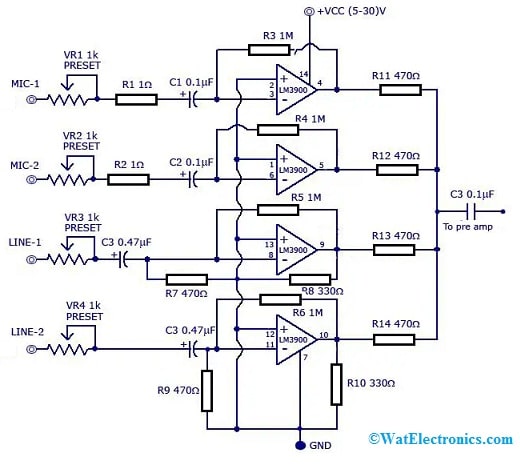An audio mixer—commonly referred to as a mixing console or mixing board—is a critical component in professional audio signal processing. It facilitates the combining, routing, and adjustment of multiple audio inputs from sources such as microphones, instruments, and playback systems. Available in analog, digital, or hybrid formats, modern mixers offer precise control over parameters like gain, equalization, panning, and effects routing, ensuring optimal tonal balance and clarity across all channels.
Professional-grade mixers are equipped with advanced features including preamplifiers, XLR and line-level inputs, adjustable trims, auxiliary sends/returns, channel EQs, and motorized faders—making them indispensable in live sound reinforcement, broadcast engineering, music production, and post-production environments.
This article focuses on the implementation of a basic audio mixer circuit using the LM3900 IC, a quad Norton operational amplifier. We will examine its architecture, pin configuration, electrical specifications, and typical applications, particularly in cost-effective analog signal mixing solutions.
What is LM3900 IC?
LM3900 is an audio mixer IC that includes four independent and high-gain frequency-compensated Norton op-amps. The LM3900 IC is a CDA or current-differencing amplifier that evaluates input currents in place of input voltages. So these op-amps were specifically designed to work from a single power supply above a wide range of voltages and they can also work from split supplies.
This mixer IC has a wide bandwidth, low supply current drain, and large output voltage swing. Thus, it can operate from 0°C to 70°C temperature. Thus, the LM3900 mixer IC can be utilized in various industrial electronic control systems and is also used to design multi-channel audio mixers.
LM3900 IC Working
LM3900 operational amplifier works with a wide range of voltages which provides good response for nearly all signal frequencies. So this op-amp includes four independent, high gain, and frequency compensated Norton op-amps. In addition, this IC can also be built with short-circuit protection and provides wide bandwidth and also large o/p voltage swing. LM3900 ICs operate with a single voltage supply to provide a large output voltage swing. So these amplifiers use current mirrors to attain in-phase input functionality.
LM3900 IC Pin Configuration:
The pin configuration of LM3900 IC is shown below. So this IC includes 14 pins which are discussed below.

LM3900 IC Pin Configuration
- Pin-1 (1IN+): It is a noninverting input pin of the first op-amp.
- Pin-2 (2IN+): It is a noninverting input pin of the second op-amp.
- Pin-3 (2IN-): It is an inverting input pin of the second op-amp.
- Pin-4 (2OUT): It is an output pin of the second op-amp.
- Pin-5 (1OUT): It is an output pin of the first op-amp.
- Pin-6 (1IN-): It is an inverting input pin of the first op-amp.
- Pin-7 (GND): It is a ground pin of op-amp.
- Pin-8 (3IN-): It is an inverting input pin of the third op-amp.
- Pin-9 (3OUT): It is an output pin of the third op-amp.
- Pin-10 (4OUT): It is an output pin of the fourth op-amp.
- Pin-11 (4IN-): It is an inverting input of the fourth op-amp.
- Pin-12 (4IN+): It is a Non-Inverting input pin of the fourth op-amp.
- Pin-13 (3IN+): It is a Non-Inverting input pin of the the third op-amp.
- Pin-14 (VCC): It is a positive voltage supply pin of op-amp.
LM3900 IC Features & Specifications:
The features and specifications of LM3900 IC include the following.
- LM3900 is a 14-pin audio mixer IC.
- It is available in SOIC-14 and PDIP-14 packages.
- It has a wide voltage supply range or with single (or) dual supplies.
- This IC has a wide bandwidth and a large o/p voltage swing.
- It is available with o/p short circuit protection and internal frequency compensation.
- Its input bias current is low.
- The maximum voltage supply is 36V.
- The maximum input current is 20mA.
- Its input bias current is 200nA.
- Its CMRR is 70 dB.
- Unity-gain bandwidth is 2.5MHz.
- Its single voltage supply is wide ranging from 4 VDC to 32 VDC.
- Input biasing current is as low as 30 nA
- It is frequently compensated internally for unity gain.
- This IC can be operated from 0°C to 70°C temperature range.
Equivalents & Alternatives:
Equivalent LM3900 ICs are; LM2900 & LM3301. Alternative audio mixer ICs are; 747 IC, NTE992, LF356, LM359, and many more.
Multi-Channel based Audio Mixer Circuit with LM3900 IC
The process of mixing multiple audio channels into a single or several audio channels is known as audio mixing. So in this audio mixing process, frequency content, source signals, dynamics, level & panoramic position are controlled. So this process is mainly used in sound recording to generate the output that is more appealing to listeners. This audio mixing process can also be done within studios to produce singles or albums. Usually, this process can be performed by the mixing engineer. At present engineers and artists are using personal computers for audio mixing.
A multi-channel-based audio mixer circuit with LM3900 IC is shown below. So the required components to make this circuit mainly include; a 32V power supply, LM3900 ICs-4, 1KΩ variable resistors-4, resistors like; 470Ω, 330Ω and 1MΩ, 0.1uf capacitors, and connecting wires. Connect this audio mixer circuit as per the circuit illustrated below.
The most significant component used in this circuit is the LM3900 IC where every input channel of this mixer can be connected to the inverting pin of the op-amp. So the op-amp of every stage amplifies each input signal individually. Each op-amp’s output is provided to a single output line with a 470 ohm resistor. Here, this circuit does not include low input impedance to combine ideal audio input channels.
The C1 to C4 polarized capacitors are simply connected to the input channels utilized for decoupling purposes. Here C5 capacitor at the output is the decoupling capacitor. So the variable resistor is simply connected to every input channel which is used to regulate the volume of the equivalent input channel.

Multi-Channel based Audio Mixer Circuit with LM3900 IC
Working
In this audio mixer circuit, the main stage is the amplifier stage where LM3900 IC is utilized as an amplifier. So the op-amps in this IC are connected as inverting amplifiers which have decoupling capacitors at their i/ps and o/ps which filters the DC component of the signals and amplifies the AC only.
Here a 1M resistor is used for feedback setup in all stages. So all A1 to A4 internal amplifiers are used to amplify the audio i/p signals. Each Op-amps A1 & A2 have two resistors like R1, R12, & R2, R11 whereas A3 & A4 op-amps have four resistors like R3, R10, R4, R5 & R6, R9, R7, and R8.
Here every audio input is controlled through VR1 to VR4 variable resistors which are connected to the inverting input of every amplifier. Here, every variable resistor simply controls the audio range of every channel before it amplifies the signal & performs the audio mix. The outputs of the four channels are mixed after flowing through four resistors of similar values R11, R12, R13 & R14.
At last, the output signals are merged for the external power amplifier. Whenever this audio mixer circuit needs a regulated DC power supply then audio signals can be given directly as input (or) can be given after pre-amplification. So it provides common GND for all non-inverting inputs. Here a sliding adjustable potentiometer is used instead of variable resistors to make the mixer circuit very professional. Thus, this circuit provides a mixed audio output signal only with the least gain, however, you can utilize an external amplifier to make the audio output signal.
Advantages & Disadvantages
The advantages of LM3900 IC include the following.
- It is operated with a single, dual, or wide voltage supply.
- It has a wide bandwidth.
- This IC output voltage swing is large.
- It has less input bias current.
- It is protected with an output short circuit.
- This is a versatile IC.
- It has four independent op-amps within a single package.
- The four op-amps within this IC can be independently used for different analog signal-processing tasks.
- This IC has less power consumption and less input bias current.
- It is well-matched with CMOS logic levels.
- It has internal compensation to avoid oscillation which makes it simple to use.
The disadvantages of LM3900 IC include the following
- These mixers have limited features and I/O options as compared to digital mixers.
- These can capture ambient noise, thus it can lead to distortion & make it harder to change recordings later.
- These are larger & heavier, thus occupying more desk space.
- Analog mixers are more vulnerable to ecological conditions & electrical surges, which can cause deformation & white noise.
- Sound mixers have limited working space for frequencies, so you may need to sacrifice some frequencies to enhance others.
- Digital mixers are more complex to function.
Applications
The applications of LM3900 IC include the following.
- The LM3900 IC can be used to form an audio mixer circuit with multi-channel.
- It can be utilized as a lamp, relay driver (or) used in positive feedback oscillators.
- This IC can be used as a line-operated audio amplifier, high-voltage non-inverting amplifier, and high-voltage inverting amplifier.
- It is used for mainly temperature sensing.
- The application areas of this audio mixer include RC active filters, AC amplifiers, low-frequency triangles, tachometers, pulse waveform and square wave generation circuits, low-speed, higher voltage digital logic gates, etc.
- The LM3900 IC is used to design a multi-channel audio mixer circuit which includes two mic audio inputs & two direct line inputs..
- In addition, it can also be utilized in power circuits like lamp & relay drivers, high voltage inverting, and non-inverting amplifiers.
- This IC is frequently used whenever fixing vintage synthesizers.
- An audio mixer is used for combining output from several microphones or channels into single (or) more common outputs.
- It is a general-purpose operational amplifier that is appropriate for a variety of analog signal processing-based applications.
Please refer to this link for the LM3900 IC Datasheet.
Thus, this is an overview of the LM3900 IC, pin-out, features, specifications, circuit, working, and its applications. Thus, this IC includes 14 pins for all four internal op-amps where every amplifier includes inverting, non-inverting & output pins. So power supply pins like Vcc & GND are very common to all the amplifiers in the IC but they work separately with high gain frequency compensation. In addition, the significant features of this IC include; low noise, large bandwidth, large output voltage swing, and high amplitude output voltage which allows amplifying audio signals without difficulties. And large output voltage swing. Here is a question for you, what is LM3301 IC?